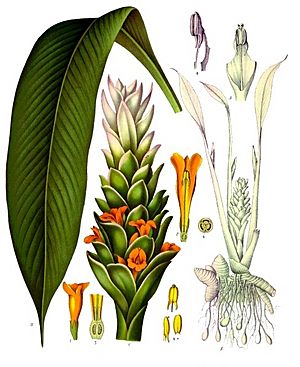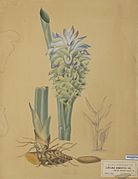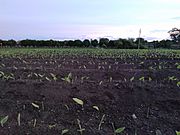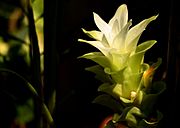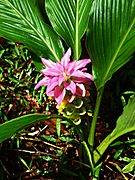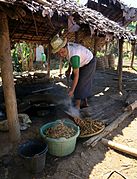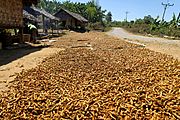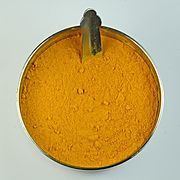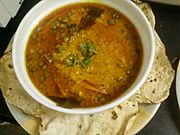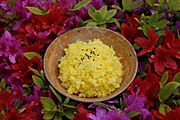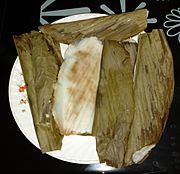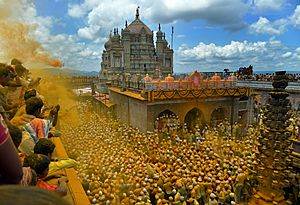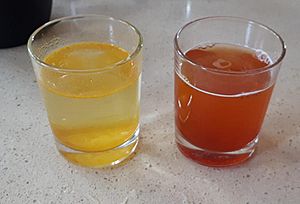Turmeric facts for kids
Quick facts for kids Turmeric |
|
|---|---|
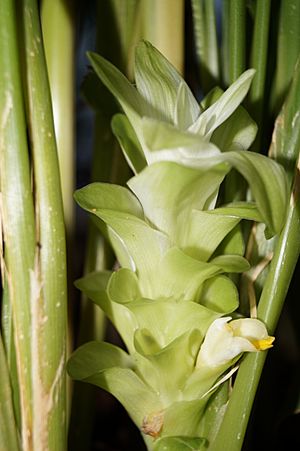 |
|
| The flower of Turmeric | |
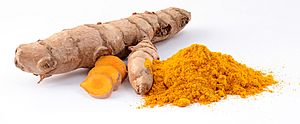 |
|
| Turmeric roots and powder | |
| Scientific classification | |
| Genus: |
Curcuma
|
| Species: |
longa
|
| Synonyms | |
|
Curcuma domestica Valeton |
|
Turmeric is a special plant from the ginger family. It's known for its bright yellow or orange roots, called rhizomes, which are used a lot in cooking. This plant grows year after year in warm places like India and Southeast Asia. It needs temperatures between 20 and 30 degrees Celsius and lots of rain to grow well.
People harvest the roots every year. Some roots are saved to plant again next season, and others are used for food. The roots can be used fresh, or they can be boiled, dried, and then ground into a bright orange-yellow powder. This powder is famous for coloring and flavoring many Asian cuisines, especially curries. It also makes a great dye because of a chemical inside it called curcumin.
Turmeric powder has a warm, slightly bitter taste, a bit like black pepper. It also has an earthy smell, similar to mustard.
Curcumin, the yellow chemical from turmeric, is approved as a food additive by big organizations like the World Health Organization and the United States Food and Drug Administration.
Even though turmeric has been used for a long time in traditional medicine systems like Ayurveda, scientists are still studying its effects. There isn't strong scientific proof yet that eating turmeric or curcumin can cure diseases.
Contents
Where Does Turmeric Come From?
Most types of Curcuma plants, including turmeric, are found in India, with about 40 to 45 different kinds. Thailand also has many types, around 30 to 40. Other warm countries in Asia have wild turmeric plants too.
Scientists are still learning about the exact types of turmeric. It seems that only the plants from South India are truly Curcuma longa. Other types sold as "turmeric" in different parts of Asia might actually be slightly different but look very similar.
A Look Back: Turmeric's History
Turmeric has been used in Asia for hundreds of years. It's a big part of traditional medicine systems like Ayurveda and traditional Chinese medicine. People first used it as a dye for clothes, and later for its believed health benefits in folk medicine.
From India, turmeric spread to Southeast Asia. This happened partly because the yellow color was used to dye the robes of monks and priests in Hinduism and Buddhism. Turmeric was even found in places like Tahiti, Hawaii, and Easter Island before Europeans arrived. This suggests that people in these areas might have started growing turmeric on their own, or it was carried by ancient travelers.
Turmeric has been found in old sites, like in India (around 2600 to 2200 BCE) and in a tomb in Megiddo, Israel (around 2000 BCE). Ancient texts from Assyria in the 7th century BCE also mention it as a dye plant. In Medieval Europe, people sometimes called turmeric "Indian saffron" because of its similar color.
What's in a Name?
The name "turmeric" might come from old English words like turmeryte. It could also come from a Latin phrase, terra merita, which means "meritorious earth."
How the Turmeric Plant Looks
Plant Appearance
Turmeric is a plant that grows back every year. It can reach up to 1 meter (about 3 feet) tall. Its roots, or rhizomes, are highly branched, yellow to orange, and smell nice.
The leaves grow in two rows. They have a long stem, or petiole, which can be 50 to 115 cm (about 20 to 45 inches) long. The leaf blades are usually 76 to 115 cm (about 30 to 45 inches) long and 38 to 45 cm (about 15 to 18 inches) wide. They are shaped like a long oval and get narrower at the tip.
Flowers and Fruit
Turmeric plants have a tall flower stalk, 12 to 20 cm (about 5 to 8 inches) long, with many flowers on it. The flowers are bright yellow. At the very top of the flower stalk, there are special leaves that don't have flowers. These are white to green and sometimes have a reddish-purple color.
The flowers themselves have three sepals (small leaf-like parts) that are fused together and are white. They also have three bright-yellow petals that form a tube up to 3 cm (about 1 inch) long. The fruit of the turmeric plant is a capsule that opens into three parts. In East Asia, turmeric usually flowers in August.
What's Inside Turmeric?
Turmeric powder is mostly carbohydrates (60-70%), with some water, protein, fat, and dietary fiber. It also contains special essential oils and curcuminoids. The beautiful golden yellow color of turmeric comes from curcumin.
Curcumin is a very important part of turmeric. It makes up about 1% to 6% of the powder. Turmeric also has many different essential oils, like turmerone and zingiberene, which give it its unique smell.
How We Use Turmeric
In the Kitchen
Turmeric is a key ingredient in many Asian dishes. It gives food a mustard-like, earthy smell and a strong, slightly bitter taste. It's mostly used in savory dishes, but sometimes in sweet ones too, like the cake sfouf. In India, people use turmeric leaves to make special sweet dishes called patoleo.
Most turmeric is used as a dried powder to add a golden yellow color to food. You can find it in canned drinks, baked goods, dairy products, ice cream, and cereals. It's also a main ingredient in curry powders. While usually used dried, fresh turmeric is also used, much like ginger. Some recipes use large pieces of fresh turmeric in pickles.
Turmeric is a popular spice in South Asian and Middle Eastern cooking. Many Iranian khoresh dishes start with onions cooked in oil and turmeric. The Moroccan spice mix ras el hanout often includes turmeric. In South Africa, turmeric colors white rice golden, creating geelrys (yellow rice), often served with bobotie.
In Vietnamese cuisine, turmeric powder colors and flavors dishes like bánh xèo. The main Cambodian curry paste, kroeung, often has fresh turmeric. In Indonesia, turmeric leaves are used in Minang or Padang curries like rendang. In the Philippines, turmeric is used in kuning and some types of adobo. In Thailand, fresh turmeric roots are used a lot, especially in southern Thai cuisine, for dishes like yellow curry.
Turmeric is also used in a popular hot drink called "turmeric latte" or "golden milk." This drink is made with milk, often coconut milk, and sometimes black pepper, following traditional recipes.
Turmeric is approved as a food color and has the code E100. It's used to color many foods, like some mustards, canned chicken broths, and other items. It's often a cheaper way to get a yellow color than using saffron.
-
Cleaning turmeric rhizomes with boiling water
-
Ganghwang-bap (turmeric rice)
-
Patoleo – sweet rice cakes steamed in turmeric leaves
Traditional Uses
In 2019, the European Medicines Agency said that turmeric herbal teas might help with mild tummy problems like feeling full or having flatulence, based on how long they've been used traditionally.
Turmeric grows wild in the forests of South and Southeast Asia. People collect it for use in traditional Indian medicine. In Eastern India, turmeric is one of nine special plants used in a ceremony called nabapatrika. The Haldi ceremony, also known as gaye holud (meaning "yellow on the body"), is a wedding tradition in Indian culture where people put turmeric paste on the bride and groom.
In parts of India, during wedding rituals, dried turmeric roots are tied to the wrists of the couple.
Turmeric isn't the best fabric dye because its color can fade in light. However, it's commonly used to color Indian clothing like saris and the robes of Buddhist monks. In the past, in Japan, turmeric was used to make colors for fabrics. In Micronesia, people used turmeric powder to decorate their bodies, clothes, and tools for ceremonies. Native Hawaiians also used turmeric to make a bright yellow dye.
As an Indicator
Turmeric paper is paper soaked in a turmeric liquid and then dried. It's used in chemistry to test if something is an acid or an alkali. The paper stays yellow in acids and neutral liquids. But it turns brown or reddish-brown in alkaline liquids. This color change happens between a pH of 7.4 and 9.2.
Keeping Turmeric Safe
Sometimes, bad things can be added to turmeric powder because it's sold by weight. Cheaper, toxic powders that look similar, like lead(II,IV) oxide (also called "red lead"), have been found mixed in. These make the turmeric look more orange-red instead of its natural golden-yellow. Because of this, some countries have stopped certain turmeric imports.
Another harmful yellow chemical, lead chromate, was found mixed into turmeric in Bangladesh. This was done to make the turmeric look brighter yellow. People who did this, from farmers to sellers, often didn't know how dangerous lead can be. Another illegal dye, metanil yellow, has also been found in turmeric. It's important to get turmeric from trusted sources to make sure it's safe and pure.
Turmeric and Health Research
Scientists have studied turmeric and curcumin in many tests to see if they can help with different health problems. While turmeric has been used in traditional medicine for a long time, more high-quality scientific studies are needed to confirm its health benefits. For example, some studies suggest that turmeric might help with knee osteoarthritis symptoms or reduce muscle soreness after exercise, but more research is still ongoing. It's also known that some people can be allergic to turmeric.
See also
 In Spanish: Cúrcuma o turmérico para niños
In Spanish: Cúrcuma o turmérico para niños


